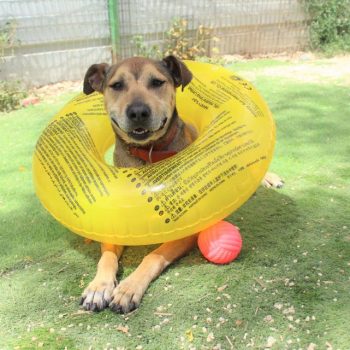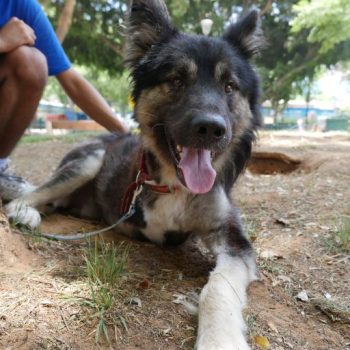How many times have you walked past the yard of a house that had a chained dog in it? How did you feel? I’m sure you were either afraid of the wild and constantly barking dog, lest he break free from the chain tied to his neck and hurt you, or you felt sadness about the miserable lonely dog who unfortunately arrived to a house which made him a living barrier to burglars or other unwanted guests. How many times have you walked past a tethered dog and found a neglected and apathetic dog that has long ago stopped responding to its surroundings and next to him is an upside-down bowl of water and a filthy environment?
This is what the life of a tethered dog looks like. Every day for years.
Tethering a dog refers to limiting the movement of a dog by a chain or similar object that is fixed to a stationary object as a way to hold him. True, there are regulations in Israel and abroad for the welfare of dogs that determine that our dogs should be protected from the ravages of the weather, and we should provide them with a clean environment as well as food and water regularly.
But make no mistake – any tethering of a dog in the yard of the house is cruel and constitutes abuse. Beyond the great physical damage, you will also cause your dog psychological damage and serious behavioral problems.
The widespread assumption that dogs’ lives in the yard are better (“because a dog needs spaces and open air”), is wrong and away from reality. The considerations of the dog owners who keep them in the yard sometimes stem from this ignorant assumption or from other reasons such as the destruction of objects in the house, defecation indoors, a desire that the dog will guard the house, will not dig in the garden, will not jump on people… and more and more. Tying the dog in the yard will not solve these problems, but will significantly exacerbate them and even yield new behavioral problems.
A dog is a social animal that needs a lot of interaction with the householders. All he wants is to be around his owner as much as possible. They need to feel part of our band and enjoy joint activities with us, at home and on a trip. Lack of attention and minimal treatment (because it is very easy to ignore and forget about the dog who is tied up in the yard and has become part of the view…) will make him feel isolated and away from the band to which he belongs. Therefore, he will usually develop serious behavioral problems and mainly aggression. Social isolation has serious consequences associated with the development of obsessive behaviors that arise from boredom and frustration. They will also be expressed in the dog’s self-harm due to restlessness by chasing its own tail, licking and itching to the point of bleeding and so forth, to the extent of making the dog very suspicious, aggressive and uncontrollable. It is important to remember that a tethered dog has no escape interval if he feels threatened, and therefore in any penetration into his territory (the tying area) he has no other choice but to fight and bite. Therefore, he will quickly become a risk and nuisance for humans and other animals.
In addition to that, the physical damage involved in tethering is very large and many dogs have died in this manner after getting entangled with the leash to the point of strangulation, or after trying to escape and jumping over the fence or another object and being hanged to death. Also, severe neck injuries will often be caused due to pulls resulting from the desire to come loose of the chain’s grip, the penetration of the collar into the skin of the neck to the point of serious injuries and complicated infections.
In addition, the tethered dog is vulnerable to severe weather. He is exposed to heavy heat and the risk of dehydration in summer, sometimes because he has no shaded place to hide and sometimes because his drinking water has spilled, and in winter he will be exposed to extreme cold and will find it difficult to heat himself. Most often, his resting place will be dirty and contaminated mainly with his own body wastes and he will find it very difficult to protect himself from various parasites and pests.
Tethered dogs are most exposed to outside dangers like other dogs entering their territory, which may attack and bite without the tethered dog being able to escape or defend himself, and also may be easily stolen by people who misuse them.
In conclusion, if you cannot give your dogs adequate conditions – to provide them with a protected roof, medical care and protection against other damages, and if you are unable to give them warmth, love, attention and various activities and do not consider them family members living with you indoors – let other people raise them.
If all you want is a watchdog, install an alarm and fence around your house. The dog is not meant to serve you and satisfy your desire to protect the house.














